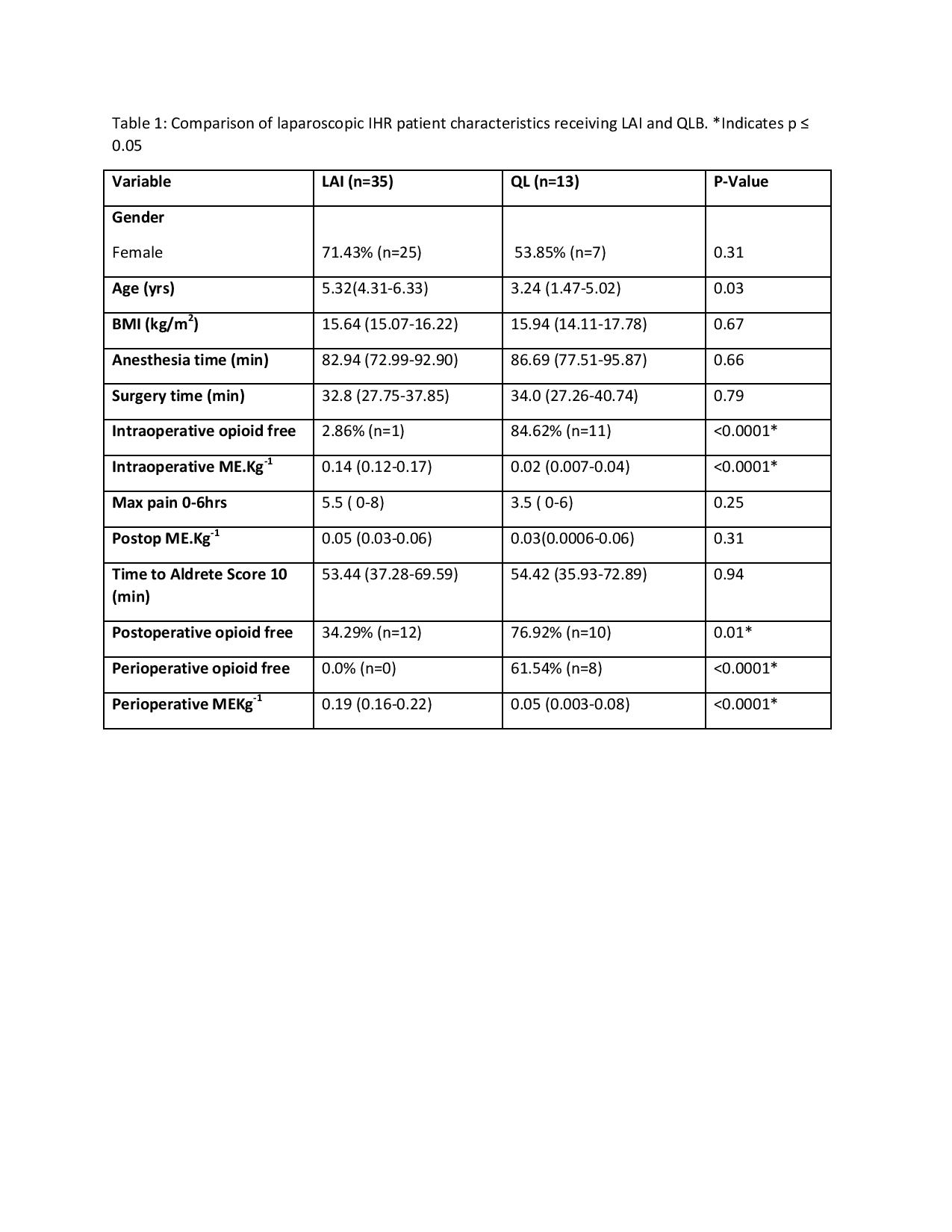NM-205
Ultrasound-Guided Quadratus Lumborum Block (QLB) for Laparscopic Inguinal Hernia Repairs: An Opioid-free Alternative
1Sindu A, 2Dowling O, 1Shah P, 2Kallis M, 2Lipskar A, 2Barnett N, 2Hagen J, 2Maloney C, 2Kars M
1Zucker School of Medicine at Hofstra/Northwell, Hempstead, NY, USA; 2Cohen Children's Medical Center, New Hyde Park, NY, United states
Introduction: Inguinal hernia repair (IHR) is the most commonly performed elective surgery in infants and children. Adequate analgesia for IHR has been traditionally achieved by caudal injection or transversus abdominis plane (TAP) blocks. Ultrasound-guided quadratus lumborum block (QLB) has recently been described as an effective analgesic technique [1,2], however, there have been few case reports on its effective use in children undergoing abdominal surgery. In this retrospective cohort study we compared the analgesic efficacy of QLB to local anesthetic infiltration (LAI) in children undergoing laparoscopic IHR. We hypothesize that the use of QLB will provide improved pain relief resulting in decreased intra- and postoperative opioid usage compared to LAI.
Methods: A retrospective chart review was performed of 48 patients aged up to 13 years who received laparoscopic IHR surgery. Thirty-five subjects received standard LAI and 13 received a preoperative QLB. The groups were compared with respect to patient characteristics such as gender, age, weight, operative and anesthesia time, total intra- and postoperative morphine-equivalent (ME) doses, maximum pain scores, time to PACU discharge readiness, and percentage of opioid free anesthesia patients. Student t-tests were used to compare groups with respect to continuous data and categorical data was compared using chi square and fisher exact test.
Results: Subjects in both groups were similar with respect to gender, BMI, anesthesia and surgical time (Table 1). Subjects in QLB group required significantly less intraoperative opioid than LAI group (0.02 ME per kg, 95% CI: 0.007-0.04) vs. (0.14 ME per kg, 95% CI 0.12-0.17) respectively, p<0.0001. While there were no significant differences in postoperative opioid consumption between groups, 77% of the QLB group remained opioid free during the postoperative period prior to discharge compared to 34.3% of the LAI group. With respect to perioperative opioid use (up until patient discharge), subjects in the QLB group required significantly less opioid than LAI group (0.05, 95% CI: 0.003-0.08) versus (0.19, 95% CI: 0.16-0.22), p<0.0001. Furthermore 61% of subjects in the QLB group were opioid free in the perioperative period compared to none in LAI group, p<0.0001 (Table 1).
Discussion: Use of preoperative QLB reduces intraoperative and perioperative opioid use compared to LAI in pediatric patients undergoing IHR. Use of the QLB also facilitated opioid free anesthesia in 61% of cases without significantly adding to anesthesia time. We propose to utilize this data to inform a future blinded randomized trial. There is an increasing appeal in the use of QLBs for regional anesthesia and well-designed larger studies are needed to establish their analgesic efficacy compared to other regional anesthetic techniques.
Top












